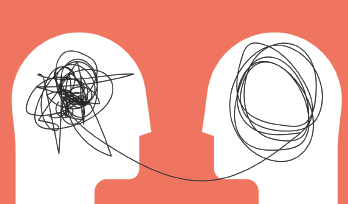
Mary Long / shutterstock.com
Rheumatology has arguably benefited like no other field from the proliferation of an increasingly effective pipeline of therapeutics. These medications have dramatically raised the bar for clinical outcomes for our patients in a way that we could not have envisioned a short generation ago. With such therapeutic progress now reaching a widening circle of rheumatic diseases, we would be justified to ask why the topic of empathy would be of interest and importance to our field?
The answer is simple and reflects the reality that our diseases (actually our patients’ diseases) are more than the sum of immune biomarkers, CDAI scores, Sharp scores, SLEDAI scores or most other commonly used metrics; they are conditions experienced by people manifesting the sum total of the human condition.
As the brilliant medical humanist Eric Cassel states in The Nature of Healing, our patients experience sickness, which has its manifestations intricately bound up in the phenomenon of meaning, while their diagnosis is what we, the providers, give to them.1 It is in this personal domain that the role of empathy in the provider-patient relationship serves as a powerful force both for the patient, for whom it helps achieve their desired goals, as well as the provider for whom, as I will argue, it can promote more meaningful work, less burnout and greater compassion.
From the outset, I assert that empathy, as an evolving field of medical science, is seriously understudied in rheumatology, which can be easily proved by a quick PubMed or Google search. I also assert that now is an ideal time to fill this void in care and caring for our patients.
Empathy in Medical Science
Most of us have an implicit internal definition of empathy and empathic behavior in our patient care interactions, and I believe most of us feel we have it. An obstacle to studying empathy is the lack of a universally accepted definition, and thus, for this review I use the definition advocated by Mohammadreza Hojat, the architect of the Jefferson Empathy Scale (JES), a psychometric test based on this definition and explicitly designed for the study of empathy in the healthcare profession.2 It has been translated into 56 languages and is the most widely used metric for quantitative study of empathy in the medcal sciences.
The construct of the JES is based on a definition that asserts that empathy is predominantly a cognitive attribute that involves an understanding of the experiences, concerns and perspective of the patient, combined with a capacity to communicate this understanding and an intention to help.
Importantly, the JES differentiates empathy from sympathy, which is clearly related, but predominantly an emotional attribute and if overabundant can potentially lead to emotional fatigue. Empathy as a cognitive function includes the critical component of perspective taking, which allows us to briefly stand in the shoes of our patients, but does not require us to live in them.
The study of empathy in providers, including physicians, nurses, medical students and other allied health professionals, has repeatedly demonstrated a variety of positive outcomes. Numerous studies performed on physicians have documented that those with higher self-reported empathy are more likely associated with increased patient satisfaction, good patient rapport, less likelihood of being sued, fewer medical errors and higher physician retention.3,4
Data also exist that support a correlation of empathy in patient care with some clinical outcomes, ranging from the treatment of the common cold, irritable bowel syndrome and enhanced control of diabetes in most but not in all studies.5-7 There is also a rich neurobiological research base on empathy demonstrating that empathy has a neurophysiologic basis and is a trait with societal and evolutionary implications.3
Our diseases (actually our patients’ diseases) are more than the sum of immune biomarkers, CDAI scores, Sharpe scores, SLEDAI scores or most other commonly used metrics.
The proposed definition of empathy includes the important role of communicating our concerns back to the patient, thus emphasizing that medical communication skills are vital to expressing our empathy, but we are not focused merely on etiquette. In fact, although good bedside manner and etiquette-based medicine are associated with improved patient satisfaction scores, such skills merely characterize the transaction of the healthcare interaction, not the actual caring for the patient.8,9 Empathy is the quality that is essential for genuine caring about, and for, our patients and the underlying principle of the maxim of France Peabody, who stated the “secret to patient care is to care for the patient,” nearly a century ago.10
What Do We Know of Empathy in Rheumatology?
The short answer is not much. Although studies of empathy in non-rheumatologic healthcare providers have documented a number of reproducible findings, such as a higher degree of empathy in providers involved in people-oriented fields (e.g., primary care, psychiatry) and higher empathy scores in women than men, no formal studies have been performed in rheumatology physicians or advanced practice providers, including comparisons to other cognitive as well as non-cognitive specialties.11
There also is a complete void of studies examining empathy in our profession as a function of type of practice (e.g., private, group, academic) or in relationship to other variables of interest, including the use of electronic medical records, volume of work, types of patients or work load, or in comparison to other cognitive or procedural subspecialties.
Finally, a critical area of unmet investigation is the relationship between healthcare provider empathy and patient outcomes, including pain control, other quality-of-life domains and other variables, including adherence to therapies.
Closing the Gap
A major goal of effective anti-rheumatic therapy is the patient’s global assessment, which to achieve remission by most disease activity scales must be 1 or less on a scale of 10. This is indeed a tall task and may be limited by a variety of complaints, including persistent pain, fatigue or general lack of psychosocial wellbeing.12 Failure to recognize such limitiations is a risk for overtreatment.
An allied area of increasing interest to our field are the nearly one in three patients who differ meaningfully in their global response regarding their disease activity with that of the score of their provider.13 Although this has been most carefully studied in rheumatoid arthritis, it is also a phenomenon documented in other conditions.14
A seminal study of this phenomenon by Davis and colleagues revealed, not surprisingly, an over-representation of fibromyalgia, intercurrent mood disorders and multi-symptomatic pain.13 In an effort to further understand these discordant responders, the researchers performed a qualitative study on a subset of these patients, revealing a number of common themes, including a major concern that their provider displayed a lack of active listening and empathy during their visits.15 Importantly, these patients, while being acutely aware of the time restraints of their clinic visit, felt their provider was often mentally appearing to be moving on to their next patient and demonstrated a general lack of presence.
Clearly the prospects of enhancing empathic communication in our field may serve to help close this important gap in treatment response.
Empathy & Interpersonal Healing

Paul Craft / shutterstock.com
In rheumatology, the placebo effect is also understudied and, in general, is viewed as an obstacle to overcome in therapeutic trials. A recent analysis of the placebo effect in RA treatment studies over time documents that its magnitude has increased in recent years, possibly due to increased expectations on the part of our patients.16
There have been major advances in the science of the placebo effect, largely dispatching the notion of the requirement of trickery and replacing it with the recognition that outcomes (i.e., placebo and nocebo effects) are powerfully influenced by therapeutic environments, including such characteristics as provider empathy, friendliness and competence.17,18
Motivational interviewing (i.e., a psychological intervention incorporated in holistic care) includes a dimension of empathic communication and has been shown to be associated with beneficial therapeutic effects in rheumatic diseases, but no studies of the direct role of provider empathy or patient-perceived provider empathy exist in rheumatologic diseases.19 Strategies to enhance empathy can positively enhance a patient’s experience and active neurobiological adaptations potentially leading to improved treatment responses, such as pain relief and improvements in quality of life.17
Obstacles to Empathy
Roadblocks to cultivating our level of empathy include our experiences at work and in our personal lives. The same challenges that are so widely discussed as risks for burnout—including our engagement in tasks peripheral to caring for patients, the challenges of the electronic medical record, the never-ending focus on productivity and declining reimbursement—all leave us too stretched to be truly empathic.9
Time limitations are among the most significant challenges, although empathic communication skills can be demonstrated and effectively communicated in only a brief moment. Studies examining the concept of time in the exam room and patient expectations confirm that when patients feel listened to, understood and cared about, the visits go faster and more smoothly and patients who are the recipients of an empathic visit tend to overestimate the time spent with the provider.20
Can Empathy Be Taught or Can We Only Lose It?
The trajectory of empathy over a life in medicine has been incompletely studied, but there is evidence that as early as the third year in medical school empathy begins to be eroded in most, but not all, students.21 Thus, can empathy be taught?
While there is clear evidence that one can teach and learn etiquette and improve the overall patient experience, we should ask ourselves whether this is enough.9 More importantly, I believe we should focus on the question of whether we can actually increase our capacity to care about our patients in the style of Francis Peabody.10
Here it becomes more challenging, but there is a growing body of data suggesting that empathy can be taught. One such study, utilizing a curriculum based in neuroscience, demonstrated enhancement of empathy in a clinical training program.22 Another study showed that non-verbal communication increased patients’ perceptions of provider empathy, with no loss in their perception of medical competence.23
In a large healthcare system, an advanced communication course based on establishing and cultivating a relationship-centered care model with patients was also found to result in significant increases in empathy measured by the JES and was accompanied by increased professional satisfaction. 24
Other techniques, especially the use of positive role modeling, engaging in narrative medicine and even reading fiction have also been demonstrated to be effective modulators of provider empathy.25
Essential to the genuine growth and development of personal empathy, however, is the notion of self-care. It is clear that although good bedside manners can be easily taught, the growth and development of personal empathy can only come when we are in balance with our work and our life.
The same obstacles to overcome and buffer burnout, such as system-level solutions to improve our daily work-life balance, are exactly what we need to enhance our sense of empathy directed toward our patients, as well as our family and those we come into contact with in our day-to-day life.
Personal wellness techniques, such as mindfulness, meditation, exercise and hobbies, also have the potential to grow our sense of caring and compassion in a way that is inexhaustible.26
Given these challenges and data it would appear to be time to explore strategies to enhance teaching empathy and empathic communication in rheumatology training programs and beyond.
I will close by recommending a book, The Empathy Effect, by Helen Reiss, an associate clinical professor of psychiatry at Harvard Medical School, Boston, and director of empathy research and training in psychotherapy research and a pioneer in empathy research. In it, Dr. Reiss emphasizes the dominance of non-verbal over verbal communication in the practice of empathy. She elegantly underscores the importance of our paying attention to the patient’s eyes, their facial muscles (all clearly compromised in the COVID era!), the tone of their voice and their mood and most importantly, in my opinion, our appraisal of the patient’s affect and their chief concern.
I have used elements from this book to teach a seminar in empathy in the Cleveland Clinic Lerner College of Medicine to the third-year students, as well as to our rheumatology fellows. I like to tell our trainees to reflect on whether or not they have a crisp review of systems for the chief concern, as opposed to the one they use to evaluate the patient’s chief complaint, which they generally do so well.
The future of the science of empathy in rheumatology is unwritten, and there are exciting opportunities to develop meaningful research and educational initiatives.
 Leonard H. Calabrese, DO, is a professor of medicine at the Cleveland Clinic Lerner College of Medicine of Case Western Reserve University, holds the R.J. Fasenmyer Chair of Clinical Immunology and the Theodore F. Classen, DO, Chair of Osteopathic Research and Education, and serves as the vice chair of the Department of Rheumatic and Immunologic Diseases at the Cleveland Clinic.
Leonard H. Calabrese, DO, is a professor of medicine at the Cleveland Clinic Lerner College of Medicine of Case Western Reserve University, holds the R.J. Fasenmyer Chair of Clinical Immunology and the Theodore F. Classen, DO, Chair of Osteopathic Research and Education, and serves as the vice chair of the Department of Rheumatic and Immunologic Diseases at the Cleveland Clinic.
References
- Cassell EJ. The Nature of Healing. New York: Oxford University Press; 2013.
- Hojat M. Empathy in Health Professions Education and Patient Care. New York: Springer International Publishing; 2016.
- Riess H. The science of empathy. J Patient Exp. 2017 Jun;4(2):74–77.
- Riess H, Kelley JM, Bailey RW, et al. Empathy training for resident physicians: A randomized controlled trial of a neuroscience-informed curriculum. J Gen Intern Med. 2012 Oct;27(10):1280–1286.
- Hojat M, Mangione S, Gonnella JS, et al. Empathy in medical education and patient care. Acad Med. 2001 Jul;76(7):669.
- Rakel DP, Hoeft TJ, Barrett BP, et al. Practitioner empathy and the duration of the common cold. Fam Med. 2009 Jul–Aug;41(7):494–501.
- Chaitoff A, Rothberg MB, Windover AK, et al. Physician empathy is not associated with laboratory outcomes in diabetes: A cross-sectional study. J Gen Intern Med. 2019 Jan;34(1):75–81.
- Kahn MW. Etiquette-based medicine. N Engl J Med. 2008 May 8;358(19):1988–1989.
- Melnick ER, Powsner SM. Empathy in the time of burnout. Mayo Clin Proc. 2016 Dec;91(12):1678–1679.
- Peabody FW. The care of the patient. JAMA. 1927;88:877–882.
- Hojat M, Gonnella JS, Nasca TJ, et al. Physician empathy: Definition, components, measurement, and relationship to gender and specialty. Am J Psychiatry. 2002 Sep;159(9):1563–1569.
- Ferreira RJO, de Wit M, Henriques M, et al. ‘It can’t be zero!’ Difficulties in completing patient global assessment in rheumatoid arthritis: A mixed methods study. Rheumatology (Oxford). 2020 May 1;59(5):1137–1147.
- Challa DN, Kvrgic Z, Cheville AL, et al. Patient-provider discordance between global assessments of disease activity in rheumatoid arthritis: A comprehensive clinical evaluation. Arthritis Res Ther. 2017 Sep 26;19(1):212.
- Lindström Egholm C, Krogh NS, Pincus T, et al. Discordance of global assessments by patient and physician is higher in female than in male patients regardless of the physician’s sex: Data on patients with rheumatoid arthritis, axial spondyloarthritis, and psoriatic arthritis from the DANBIO registry. J Rheumatol. 2015 Oct;42(10):1781–1785.
- Kvrgic Z, Asiedu GB, Crowson CS, et al. ‘Like no one is listening to me’: A qualitative study of patient-provider discordance between global assessments of disease activity in rheumatoid arthritis. Arthritis Care Res (Hoboken). 2018 Oct;70(10):1439–1447.
- Bechman K, Yates M, Norton S, et al. Placebo response in rheumatoid arthritis clinical trials. J Rheumatol. 2020 Jan;47(1):28–34.
- Blasini M, Peiris N, Wright T, Colloca L. The role of patient-practitioner relationships in placebo and nocebo phenomena. Int Rev Neurobiol. 2018;139:211–231.
- Colloca L, Barsky AJ. Placebo and nocebo effects. N Engl J Med. 2020 Feb 6;382(6):554–561.
- Georgopoulou S, Prothero L, Lempp H, et al. Motivational interviewing: Relevance in the treatment of rheumatoid arthritis? Rheumatology (Oxford). 2016 Aug;55(8):1348–1356.
- Hardee JT, Platt FW. Exploring and overcoming barriers to clinical empathic communication. J Commun Healthc. 2010;3(1):17–23.
- Hojat M, Vergare MJ, Maxwell K, et al. The devil is in the third year: A longitudinal study of erosion of empathy in medical school. Acad Med. 2009 Sep;84(9):1182–1191.
- Riess H. Empathy training for health care providers. Health Aff (Millwood). 2020 Jun;39(6):1097.
- Kraft-Todd GT, Reinero DA, Kelley JM, et al. Empathic nonverbal behavior increases ratings of both warmth and competence in a medical context. PloS One. 2017 May 15;12(5):e0177758.
- Boissy A, Windover AK, Bokar D, et al. Communication skills training for physicians improves patient satisfaction. J Gen Intern Med. 2016 Jul;31(7):755–761.
- Hojat M. Ten approaches for enhancing empathy in health and human services cultures. J Health Hum Serv Adm. 2009 spring;31(4):412–450.
- Calabrese LH. Why mindfulness/meditation is a ‘no-brainer’ for health-care professionals. J Patient Exp. 2019 Mar;6(1):21–23.


